The 12 Best Fruits To Grow In Containers
No garden? No problem—grow a variety of delicious fruits on your porch or patio.
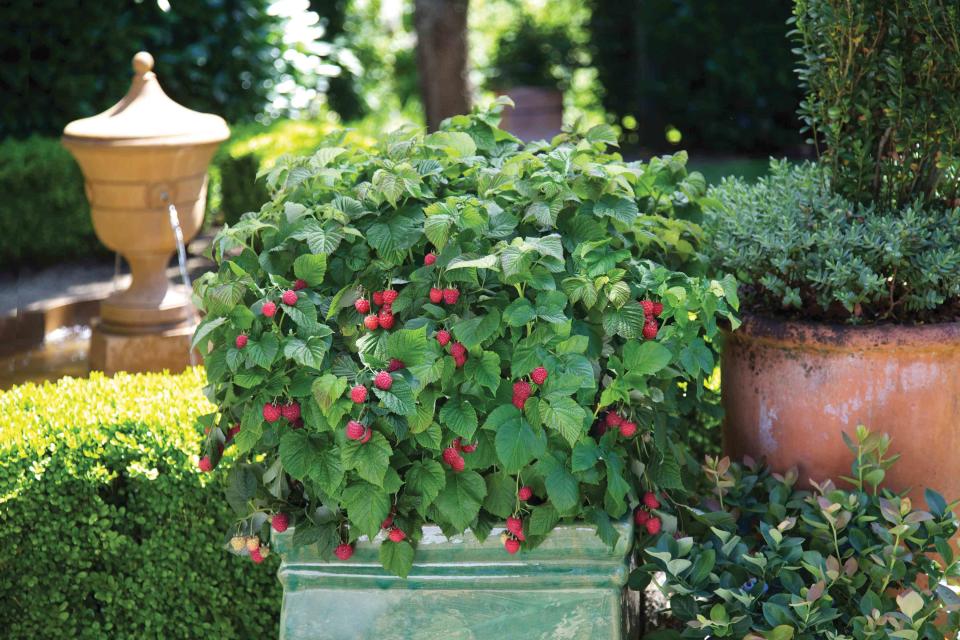
Star Roses and Plants
You don’t need a lot of space to grow nutritious fruits at home. From berries to citrus, a diversity of fruit crops performs beautifully in containers. With careful cultivar selection and regular care, you can grow your own blueberries, figs, and more. We’ve rounded up twelve of the best fruits for containers, focusing on those that are the easiest and most productive in pots. In addition to tasty fruits, these plants also add beautiful flowers and foliage to your outdoor living spaces.
Growing fruits in containers can provide some advantages over in-ground fruit production. You can grow fruits from outside your hardiness zone, provided you have a protected place to store containers during the winter months. Likewise, when unexpected spring freezes arrive, we can move sensitive container-grown fruits to shelter. And it is much easier to adjust soil conditions such as pH in containers, allowing you to grow crops with vastly different needs in a small space.
Tips for Growing Plants in Containers
The size of the containers is important and will influence the plants you can grow. The key is providing enough room for plants to develop a healthy root system. We also need to ensure adequate water availability, as most fruit plants require a large amount of water. Wooden barrels are popular for larger fruit crops, but you can also use decorative plastic or ceramic containers, provided they hold enough soil and have good drainage.
Fruit containers can become very heavy, especially ceramic ones. It is a good idea to use soil-less media in your containers as these are lightweight and provide excellent drainage. For crops that require wintering indoors, consider using a plant stand with rollers to make moving easier. Keep containers watered well as they tend to dry out quickly, particularly during the heat of summer.
Pay careful attention to winter hardiness when selecting plants for containers that will remain outdoors throughout the winter months. Roots in containers are not as well insulated as plants in the ground and cannot withstand temperatures as low as their in-ground counterparts. For the greatest success, select plants hardy to two zones colder than your USDA hardiness zone when overwintering plants outside.
Related: The 6 Best Vegetables For Container Gardening
Strawberries
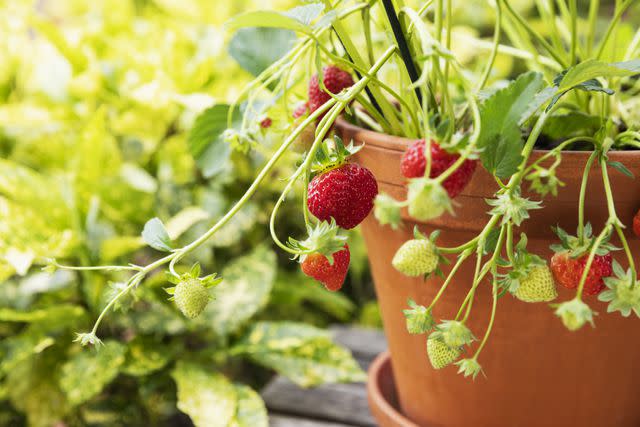
Getty Images / Westend61
Botanical Name: Fragaria x ananassa
Sun Exposure: Full Sun
Soil Type: Moist, Well-draining, Rich
Soil pH: Slightly Acidic (5.5-6.8)
Strawberries have long been grown in pots and even have a unique style of container named for them: the strawberry pot. Usually made from terracotta, these large urn-shaped containers have several pocket-like openings along their sides for tucking individual plants. This prevents overcrowding, which can limit productivity. You can also grow strawberries in traditional pots and hanging baskets. Snip off the early-season runners to encourage plants to direct energy into fruit production.
'Little Miss Figgy' Dwarf Fig
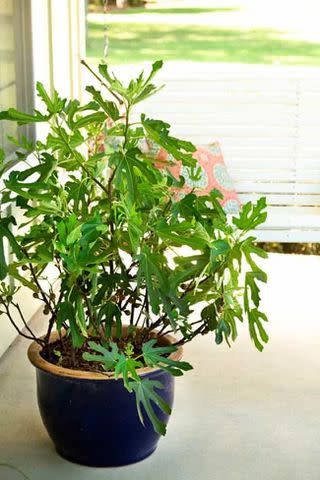
Southern Living Plant Collection
Botanical Name: Ficus carica 'Little Miss Figgy'
Sun Exposure: Full Sun
Soil Type: Medium, Well-draining
Soil pH: Slightly Acidic (5.8 to 6.5)
Finding fresh figs can be challenging, as these fruits do not store well. This is why growing your own figs is so rewarding. While many different varieties of fig can be grown in pots, 'Little Miss Figgy' seems tailor-made for containers. A dwarf version of the Violette de Bordeaux fig, 'Little Miss Figgy' produces both a breba (early) and a main crop of delicious fruits on plants growing only 4 to 8 feet tall and 3 to 4 feet′ wide. The broad foliage of figs makes them a beautiful addition to the patio.
Baby Cakes® Thornless Blackberry
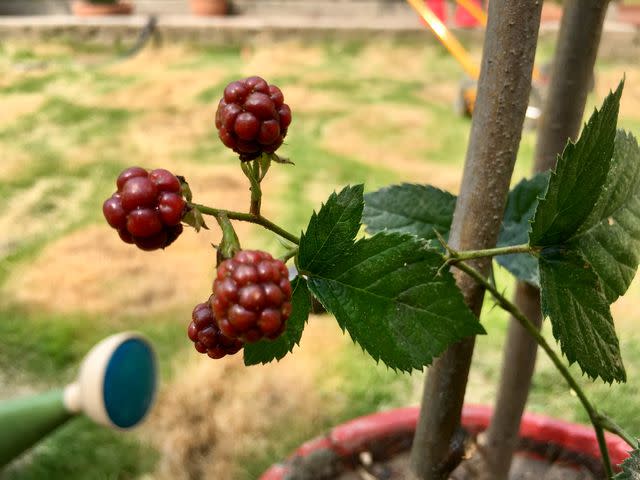
Getty Images / Bilal photos
Botanical Name: Rubus hybrid 'APF-236T'
Sun Exposure: Full Sun
Soil Type: Medium, Well-draining, Average
Soil pH: Slightly Acidic (5.5-6.5)
This thornless blackberry grows as a compact, rounded mound rather than long sprawling canes, making it much more attractive for growing in containers and among ornamental plantings than traditional blackberry plants. Plants fruit on both first year (primocane) and second year (floricane) stems, providing two harvests of irresistibly sweet berries—one in July and a second starting in September.
Blueberries
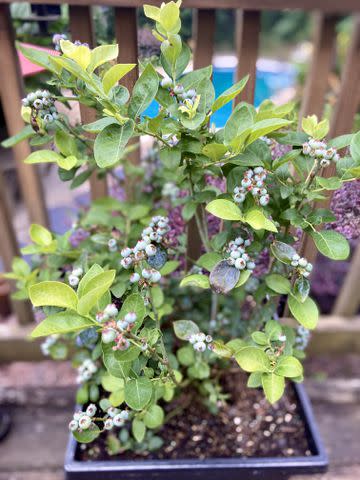
Getty Images / Alison Rose
Botanical Name: Vaccinium species and hybrids
Sun Exposure: Full Sun
Soil Type: Well-draining, Peaty
Soil pH: Acidic (4.5-5.2)
Blueberries are gorgeous plants, providing spring blooms, summer fruits, and ruby-red fall color. Planting blueberries in containers is a great way to grow these fruiting shrubs in locations where soil pH is too high. To provide blueberries with an acidic growing medium, plant them in a mixture of 50% peat moss and 50% potting soil. Peat can be challenging to re-wet after it dries. Wet it thoroughly before potting your blueberry plants and maintain consistent moisture through regular watering.
Passion Fruit
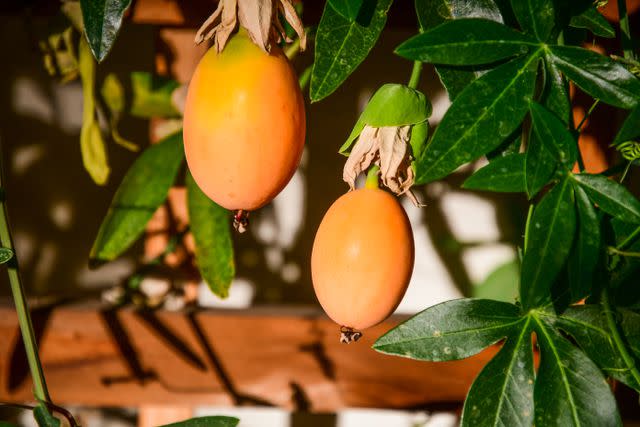
Getty Images / Barbara Rich
Botanical Name: Passiflora edulis
Sun Exposure: Full Sun
Soil Type: Medium to Moist, Well-draining, Rich
Soil pH: Slightly Acidic to Neutral (6.5-7.5)
If you’ve ever tasted Hawaiian Punch, you know the distinct flavor of passion
fruit. These tender tropical vines can be grown in containers and brought indoors over the winter months (winter hardy in zones 9B-11). In addition to the egg-shaped fruits, passion fruit is grown for its gorgeous, frilly blooms. The plants also serve as a host plant for larvae of the gulf fritillary butterfly, a beautiful orange visitor throughout the summer.
Dwarf Peach
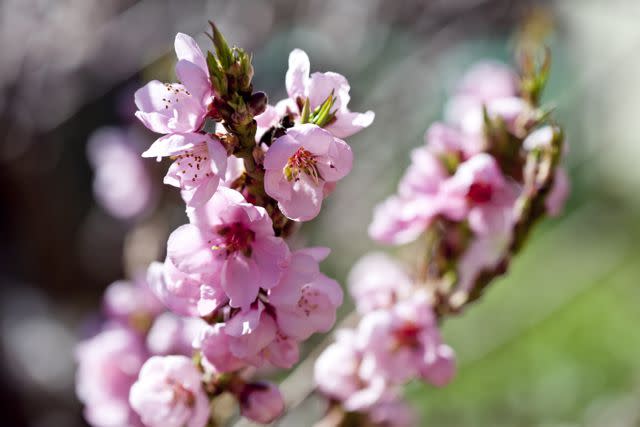
Getty Images / Jenny Dettrick
Botanical Name: Prunus persica 'Pix Zee'
Sun Exposure: Full Sun
Soil Type: Medium, Well-draining, Average Fertility
Soil pH: Slightly Acidic to Neutral (6.0-7.0)
Peach trees make lovely patio plants, their elongated foliage trees is highly attractive, and the showy pink blooms are wonderfully fragrant. A variety of dwarf peach and nectarine selections are available, some with more than one cultivar grafted to the same rootstock. The variety 'Pix Zee' produces juicy, freestone peaches on plants that mature at 5 to 6 feet tall. 'Pix Zee' only requires 400 chilling hours to bloom, making it a good selection for southern gardens. Peach trees require large containers—25 gallons or bigger.
Raspberry Shortcake®
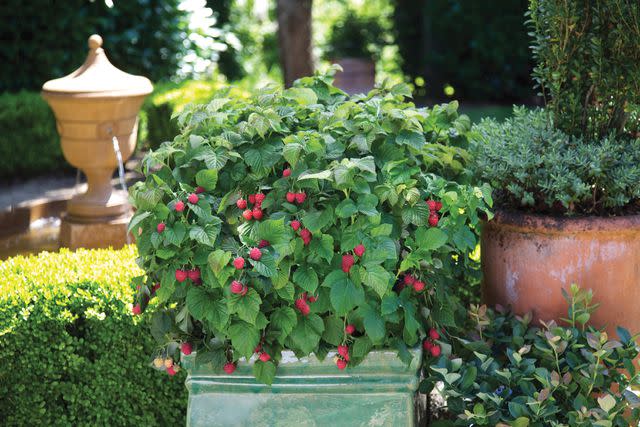
Star Roses and Plants
Botanical Name: Rubus idaeus 'NR7'
Sun Exposure: Full Sun to Part Shade
Soil Type: Moist, Well-draining, Rich
Soil pH: Slightly Acidic (5.5-6.5)
Raspberry Shortcake® is an altogether different kind of raspberry. Thornless and compact, Raspberry Shortcake® was bred for life in containers. It produces sweet fruits on first year canes, making pruning a breeze. The only drawback is the 800 chilling hours (accumulated hours of cold temperatures) required for fruit production, which limits how far south you can grow this raspberry (and most others). The cut off is roughly USDA Hardiness Zone 8 but consult a regional chilling hour map for more accurate estimates.
Pineapple
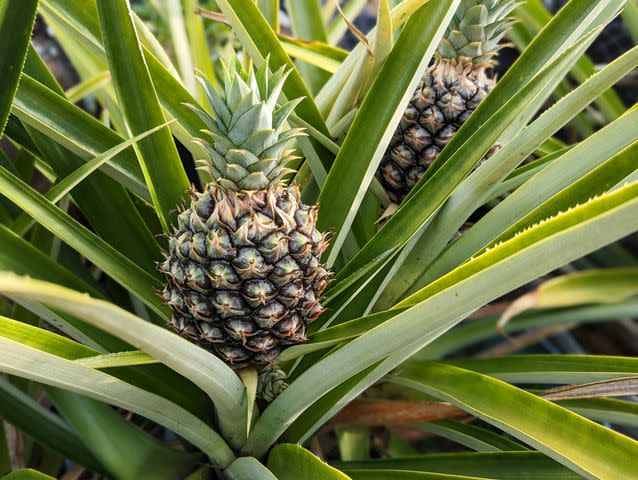
Getty Images / Cathy Scola
Botanical Name: Ananas comosus
Sun Exposure: Full Sun
Soil Type: Medium, Well-draining, Rich
Soil pH: Acidic (4.5-6.5)
If you’ve ever grown a pineapple plant from the crown of a purchased fruit, you already know how easy this tropical treat is to grow. They also take up less space than most other fruit crops on this list, growing happily in 3- to 7-gallon containers. However, it takes a long time to produce fruit, typically between 18 and 24 months. Potted plants will bear best if grown outdoors during the summer months. In winter, move them to a sunny window indoors.
Meyer Lemon
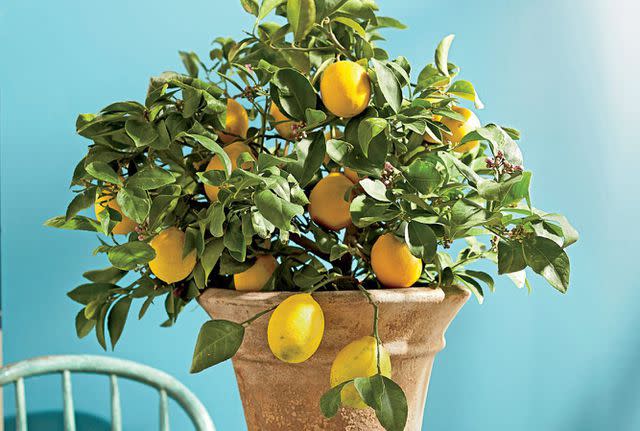
Hector Sanchez
Botanical Name: Citrus × meyeri
Sun Exposure: Full Sun to Part Shade
Soil Type: Moist, Well-draining
Soil pH: Acidic to Neutral (5.5 to 8.0)
If the zesty fruits of Meyer lemon aren’t enough to make you grow this tropical delight, the heaven-scented blooms are sure to persuade you. A favorite of bakers and mixologists, the rounded fruits have a sweeter flavor than regular lemons and can be produced year-round in hot climates. Meyer lemon trees are hardy to zone 8B/9A and should be wintered indoors in colder climates. Outside, plants benefit from afternoon shade in hot locales.
Bambina™ Pineapple Guava
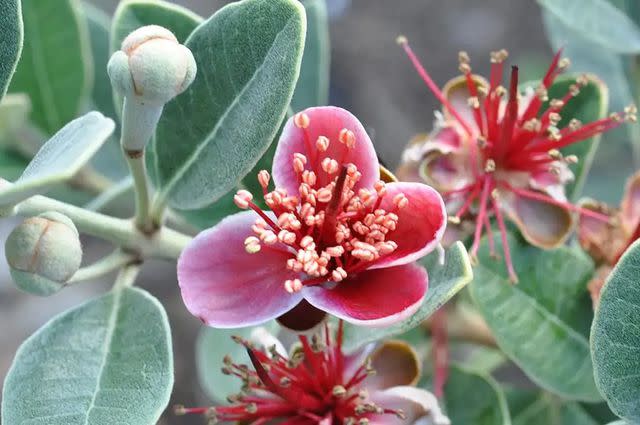
Southern Living Plant Collection
Botanical Name: Feijoa sellowiana 'Tharfiona'
Sun Exposure: Full Sun
Soil Type: Moist, Well-draining, Rich
Soil pH: Slightly Acidic to Neutral (5.5-7.0)
This uncommon tropical shrub produces exotic blooms and green egg-shaped fruits, both of which are edible. The stunning flowers boasts white and pink petals surrounding crimson anthers and can be eaten like candy. Of course, you’ll want to leave some to produce the gold-fleshed fruits. 'Bambina' is a dwarf selection that grows as a 3- to 4-foot mounding shrub. The small leaves are green above and whitish below, giving plants a lovely silver sheen.
Pomegranate
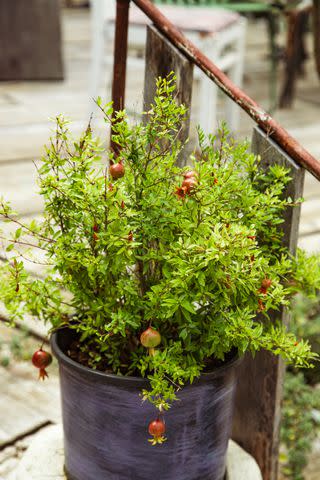
Getty Images / Ton Khivintsev
Botanical Name: Punica granatum
Sun Exposure: Full Sun
Soil Type: Medium, Well-draining
Soil pH: Slightly Acidic to Neutral (5.5-7.2)
Pomegranates are adored for their flashy red-orange blooms that seem to twirl like dancers’ skirts. Their popularity has led to the production of several dwarf cultivars, but only some of these bear tasty fruits. For container production, look for varieties that balance compact size and edible fruits, such as Crimson Sky™ and Favorite™. These showy shrubs make great focal points for patio pots.
'Sugar Baby Bush' Watermelon
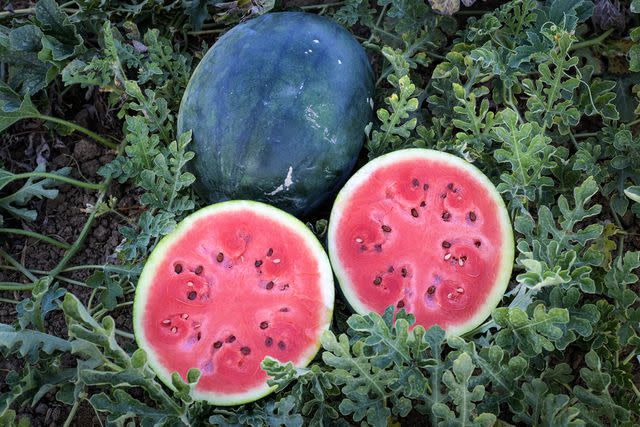
Baker Creek Heirloom Seed Co. / rareseeds.com.
Botanical Name: Citrullus lanatus 'Sugar Baby Bush'
Sun Exposure: Full Sun
Soil Type: Moist, Well-draining, Rich
Soil pH: Slightly Acidic to Neutral (6.0-7.5)
Most watermelon varieties produce long vines that will quickly swallow up your patio, but not 'Sugar Baby Bush'. With vines growing just three feet long, this compact cultivar saves space while still delivering delicious flavor. Each vine produces two to three melons weighing up to ten pounds each. Sow seeds or set transplants in containers that hold 7-10 gallons of soil per plant. Watermelons are heavy feeders and require a low-nitrogen, high phosphorous fertilizer. Too much nitrogen promotes vine growth at the expense of fruits.
For more Southern Living news, make sure to sign up for our newsletter!
Read the original article on Southern Living.

